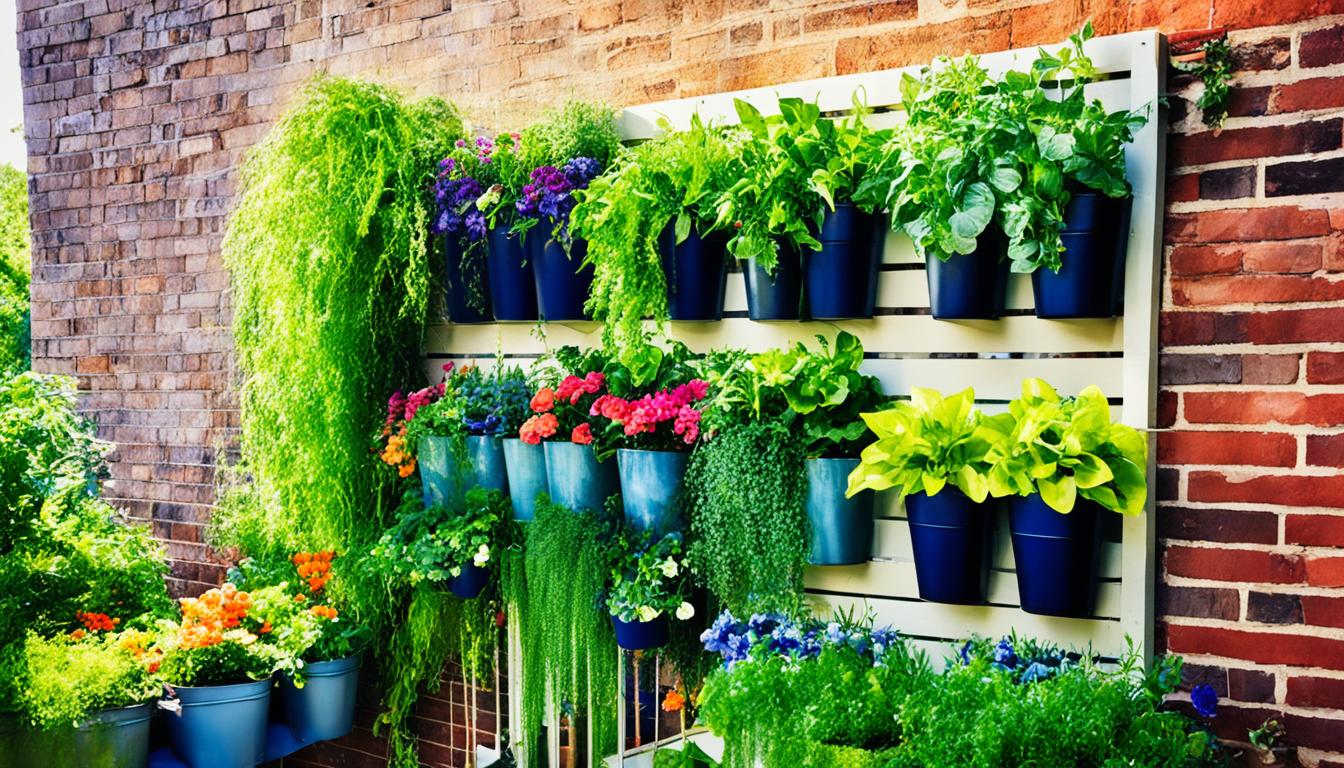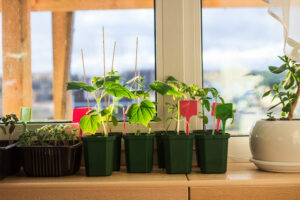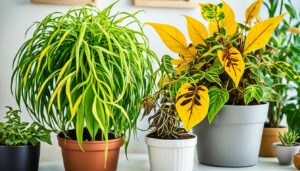Ever dreamed of having a lush garden but thought it was too hard with a small balcony or backyard? A DIY vertical garden could be your answer. These gardens turn tiny spots into green havens, bringing nature right to your city home.
Vertical gardening is a big deal for those with little space. It lets you grow many plants up high, saving your floor space. You can grow fresh herbs or beautiful flowers, all in a small area.
With some creativity and the right tools, you can make a DIY vertical garden. It will not only increase your growing space but also make your home look unique. You can use old pallets or hanging planters for a creative touch.
Key Takeaways
- Vertical gardens maximize growing space in small areas
- DIY vertical gardens are suitable for balconies, patios, and tiny yards
- You can grow vegetables, herbs, and ornamental plants vertically
- Vertical gardening reduces weeding and pest issues
- Space-saving garden solutions enhance home aesthetics
- Vertical gardens improve air circulation for healthier plants
Introduction to Vertical Gardening
Vertical gardening turns small spaces into lush green havens. It lets you grow plants upwards, making the most of limited room. Let’s dive into the world of vertical gardens and see how they can beautify your space.
What is vertical gardening?
Vertical gardening means growing plants on vertical surfaces. It’s a creative way to grow crops, herbs, and flowers in small spots. You can use walls, fences, or freestanding structures for stunning green displays. This method is ideal for city dwellers and those with little outdoor space.
Benefits of vertical gardens in small spaces
Vertical gardens bring many benefits to small-space owners:
- Space optimization: Grow more plants in less area
- Improved air quality: Plants act as natural air purifiers
- Aesthetic appeal: Create eye-catching green displays
- Increased privacy: Use plants as living screens
- Better accessibility: Tend to plants without bending or kneeling
Types of vertical garden structures
Check out these popular vertical garden structures for your indoor projects:
| Structure | Description | Best for |
|---|---|---|
| Trellises | Lattice frameworks for climbing plants | Vines, peas, beans |
| Stackable planters | Modular containers that stack vertically | Herbs, succulents, flowers |
| Hanging baskets | Suspended containers for trailing plants | Petunias, ferns, strawberries |
| Living walls | Entire walls covered with plants | Ferns, bromeliads, air plants |
With these DIY ideas, you can turn any small space into a lush garden oasis. Get creative and start your vertical gardening journey today!
Planning Your DIY Vertical Garden
Starting a DIY vertical garden for small spaces means planning well. First, measure the area you have. Think about how much sunlight it gets during the day. This helps you pick the right plants and structure.
Then, check how much weight your walls or supports can hold. Vertical gardens can be heavy when they’re full of water. Make sure your spot can safely carry the weight.
Getting water right is key for vertical gardens in small spaces. Plan for good water drainage to avoid damage. Think about using a drip irrigation system for easy care.
Pick plants that do well in vertical gardens and fit your space. Mix different types for looks and function. Here’s a guide to get you started:
| Plant Type | Examples | Sunlight Needs | Water Requirements |
|---|---|---|---|
| Herbs | Basil, Mint, Thyme | Full sun to partial shade | Moderate |
| Succulents | Echeveria, Sedum, Burro’s Tail | Full sun | Low |
| Ferns | Boston Fern, Maidenhair Fern | Partial to full shade | High |
| Flowering Plants | Petunias, Pansies, Impatiens | Full sun to partial shade | Moderate to high |
With careful planning, your DIY vertical garden will be a lush, green spot. It will make the most of your small area, adding beauty and function to your home.
Choosing the Right Plants for Your Vertical Garden
Choosing the right plants is key for a successful vertical garden. Whether you’re using vertical planters for small spaces or indoor gardening, picking the right plants matters. Let’s look at some great options for your vertical garden.
Vining Vegetables and Fruits
Vining plants are great for vertical gardens. They grow upwards naturally, fitting well in space-saving vertical structures. Here are some top picks:
- Cucumbers
- Pole beans
- Peas
- Melons
- Grapes
Herbs and Leafy Greens
Herbs and leafy greens work well in indoor vertical gardens. They’re compact, don’t weigh much, and often need shallow soil. Here are some good ones to try:
- Basil
- Cilantro
- Lettuce
- Spinach
- Arugula
Ornamental Plants and Flowers
Add beauty to your vertical garden with ornamental plants and flowers. They can turn vertical planters into beautiful living walls:
- Climbing roses
- Wisteria
- Clematis
- Jasmine
- Climbing hydrangea
| Plant Type | Sunlight Needs | Water Requirements | Growth Rate |
|---|---|---|---|
| Vining Vegetables | Full sun | Moderate | Fast |
| Herbs | Partial to full sun | Low to moderate | Moderate |
| Ornamental Plants | Varies by species | Moderate | Slow to moderate |
Think about each plant’s growth habits, sunlight needs, and weight when planning your garden. With the right plants, you’ll have a beautiful, thriving garden that saves space.
DIY Vertical Garden Structures and Materials
DIY vertical garden ideas are endless for saving space. The materials and structures you choose are key to your green wall’s success. Let’s look at some top options to help you make the perfect vertical garden.
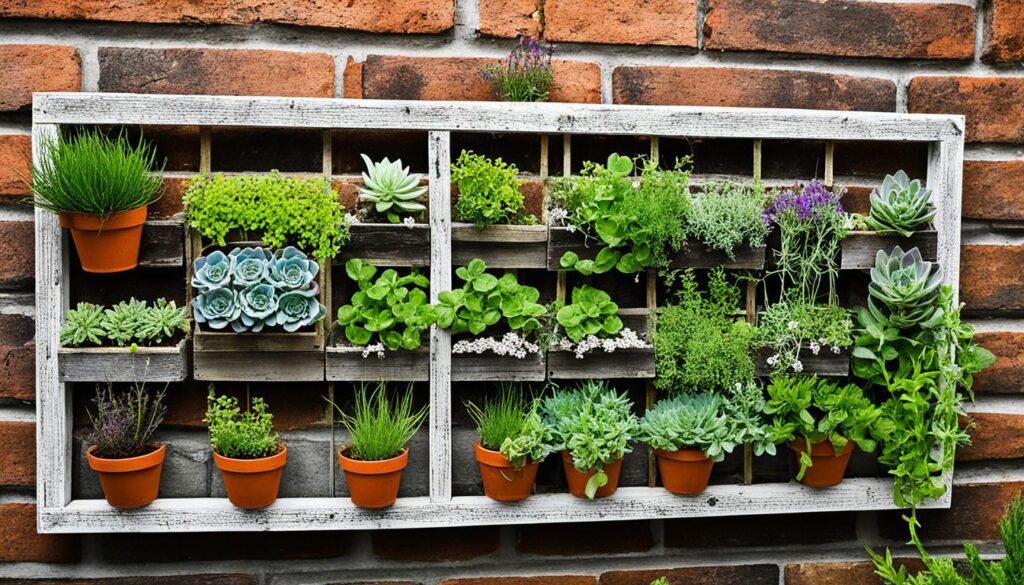
Wood is a top pick for vertical gardens. It’s versatile, looks natural, and is easy to work with. You can make strong trellises or frames for climbing plants. Or, use old pallets to create charming planters for a rustic look.
Metal structures are durable and modern. Use wire mesh or steel frames for sleek designs that can handle outdoor weather. They’re great for supporting heavy plants or making detailed patterns on your wall.
Plastic is a budget-friendly option for vertical gardening. Choose stackable planters and hanging pockets made from recycled stuff for an eco-friendly touch. They’re ideal for renters or those who want gardens they can move easily.
- Repurposed items: Turn old gutters, shoe organizers, or wooden crates into unique planters
- Modular systems: Pre-made vertical garden kits for easy installation and customization
- Living walls: Professional-grade systems for large-scale green walls
Think about weight, water resistance, and upkeep when picking materials. Your vertical garden should fit your space and support your plants well.
“The best vertical gardens blend form and function, turning empty walls into lush, living art pieces.”
With these DIY ideas, you’re set to make beautiful space-saving gardens. Get creative and watch your walls turn into lush green spaces!
Trellises: A Versatile Vertical Gardening Solution
Trellises are a great way to make the most of your DIY vertical garden. They help climbing plants grow, turning plain walls into beautiful gardens. Let’s dive into the world of trellises and see how they can boost your small space gardening.
Types of Trellises
There are many types of trellises for different spaces and needs. Freestanding trellises are good for open areas, while wall-mounted ones save space. A-frame trellises support plants on both sides, ideal for small spaces.
Best Plants for Trellis Growing
Some plants do really well on trellises, making your DIY garden look great and productive. Vining veggies like cucumbers and pole beans grow well vertically. Flowers like morning glories and clematis add color to your garden.
| Plant Type | Examples | Growth Rate |
|---|---|---|
| Vegetables | Cucumbers, Pole Beans, Peas | Fast |
| Fruits | Grapes, Kiwi, Passion Fruit | Moderate |
| Flowers | Morning Glories, Clematis, Jasmine | Varies |
DIY Trellis Ideas
Building your own trellis is a fun and budget-friendly project. You can use old ladders for a unique look or make a simple grid with bamboo. Wire mesh panels are strong and flexible for small spaces. With these DIY ideas, your vertical garden will look great and show off your style.
Stackable Planters: Space-Saving and Resource-Efficient
Stackable planters are a big win for city gardeners looking to use space wisely. They let you grow more in less space without wasting resources.
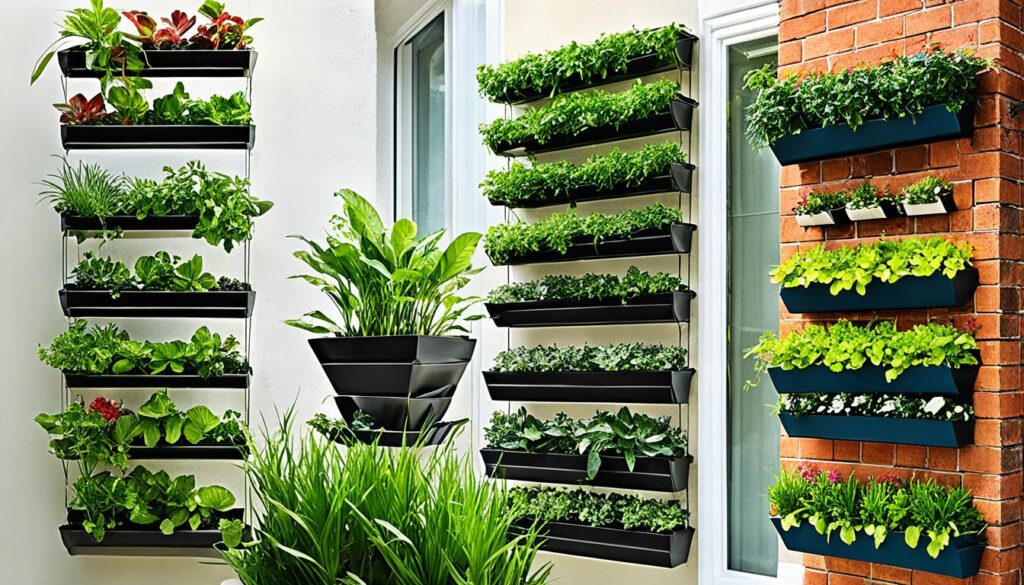
The Greenstalk 7 Tier Vertical Planter is a top choice for small gardens. It lets you grow strawberries, leafy greens, herbs, and small veggies in one spot. This makes the most of your limited space.
Stackable planters bring many benefits:
- They use soil, water, and fertilizer wisely.
- They’re easy to move and turn for better sunlight.
- They’re great for gardeners who have trouble moving around.
- You can customize them to fit your space and plant choices.
To set up your stackable planter, begin with a solid base. Add more tiers as you need them, making sure each one is stable. Fill with good potting mix and plant your favorites. Water from the top, letting any extra drain through each level.
Play with different plant mixes. Mix fast-growing lettuce with peppers that take longer to mature. Or try a vertical herb garden with basil, cilantro, and mint. These planters open up a world of possibilities for small gardens.
Hanging Gardens: Easy and Low-Cost Vertical Options
Hanging gardens are great for those who love DIY vertical gardening. They save space and don’t cost much. Let’s look at some creative ways to make your space look amazing.
Hanging Basket Ideas
Hanging baskets are great because they keep pests away from plants. You can add a bohemian vibe with macramé plant hangers. Fill them with plants like ivy or petunias. Or, use old colanders for a unique and eco-friendly planter.
Daisy Chain Hanging Pots
Make a beautiful display with daisy chain hanging pots. Link several small pots together with rope or chains. This is perfect for herbs or small plants. The hanging effect makes any wall or balcony look great.
Creating a Plant Curtain
Plant curtains add privacy and beauty. Use a strong rod and hanging planters to create a living screen. Choose plants like pothos or string of pearls for the best look. This is ideal for dividing spaces or decorating big windows.
| Hanging Garden Type | Best Plants | DIY Difficulty |
|---|---|---|
| Hanging Baskets | Petunias, Fuchsias, Ivy | Easy |
| Daisy Chain Pots | Herbs, Succulents | Moderate |
| Plant Curtain | Pothos, String of Pearls | Challenging |
These hanging garden ideas show that vertical gardening can be affordable and beautiful. With creativity, you can make a stunning DIY garden. It will use your space well and show off your green skills.
DIY Vertical Garden Maintenance and Care
Your DIY vertical garden needs regular care to thrive. Make sure to water your plants often, as they can dry out quickly. Check the soil moisture every day and adjust your watering schedule as needed.
For indoor vertical gardening, use a spray bottle or watering can with a narrow spout. This makes it easy to water all your plants.
Feeding your plants is key for healthy growth. Use a balanced, water-soluble fertilizer every two weeks during the growing season. Prune your plants often to keep them looking good and encourage bushy growth. This is very important for vining plants in your DIY vertical garden.
Watch out for pests and diseases. Check your plants weekly for signs of trouble like yellowing leaves or tiny bugs. If you find any problems, treat them quickly with organic pest control methods.
Good air circulation helps prevent fungal problems. Make sure your vertical garden has enough space between plants.
Think about getting a drip irrigation system for easier care of your DIY vertical garden. This can save you time and make sure your plants get the right amount of water. Remember, each plant has its own care needs. Do some research on the specific needs of your plants for the best results in your indoor vertical garden.
FAQ
What is vertical gardening?
Vertical gardening is a way to grow plants upwards instead of outwards. It uses vertical structures to make the most of small spaces.
What are the benefits of vertical gardens in small spaces?
Vertical gardens have many perks. They reduce weeding and pests, and are easier to maintain. They also make the most of small areas, boost biodiversity, and clean the air in cities.
What types of vertical garden structures are common?
You’ll often see trellises, stackable planters, and hanging containers like baskets or pots. These are popular choices for vertical gardens.
How do I plan a DIY vertical garden?
Start by looking at your space and how much sunlight it gets. Think about what your structures can hold and how they’ll drain water. Pick the right plants and consider how you’ll take care of them. Choose the best vertical garden structure for your area.
What plants are suitable for vertical gardens?
Great plants for vertical gardens include vining veggies like cucumbers and peas. You can also grow fruits, herbs, and leafy greens. Ornamental plants like roses and hydrangea work well too. Just pick plants that fit your space and sunlight.
What materials can be used for DIY vertical garden structures?
You can use wood, metal, plastic, or recycled items like pallets or gutters for your garden. Trellises, stackable planters, and hanging baskets are popular choices.
What are the best plants for growing on trellises?
For trellises, go with cucumbers, pole beans, peas, and climbing flowers. You can make your trellis with bamboo poles, old ladders, or wire mesh panels.
What are the advantages of stackable planters?
Stackable planters save space and resources like soil and water. They’re perfect for growing strawberries, greens, herbs, and small veggies.
How can I create hanging gardens?
Hanging gardens are simple and affordable. Use hanging baskets, daisy chain pots, or plant curtains to add greenery to small areas.
How do I maintain a DIY vertical garden?
Keep your vertical garden healthy with regular watering and fertilizing. Prune plants and watch out for pests. Make sure your garden drains well and use smart watering systems like drip irrigation.
Source Links
- https://www.pinterest.com/pin/back-yard-patio-pool-flower-gardens–495044184042733673/ – {The BEST} DIY Vertical Gardens for Small Spaces | Vertical garden diy, Diy garden projects, Vertical garden planters
- https://wholemadehomestead.com/vertical-gardening-for-small-spaces/ – Vertical Gardening for Small Spaces – WholeMade Homestead
- https://www.epicgardening.com/vertical-garden/ – 4 Ways to Grow Vertical Gardens in Small Spaces


